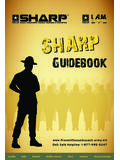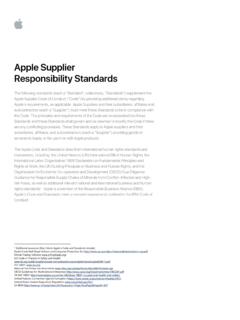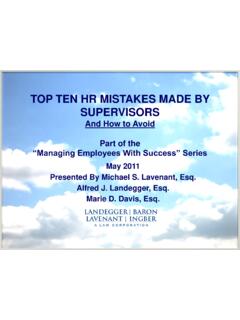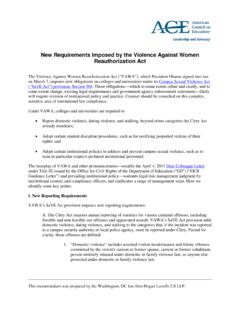Transcription of Peer on Peer Abuse Guidance and Model policy
1 1 Peer on Peer Abuse Guidance and Model policy Please Note: This policy template remains current and in line with the statutory Guidance contained within Keeping Children Safe in Education 2020, Working Together to Safeguard Children 2018 and Nottinghamshire Safeguarding Children Partnership policy , Practice and Guidance as of August 2019. KCSIE 2020 was republished as of September 2020 and is now statutory What is Peer on Peer Abuse ? All children are capable of abusing their peers. This can manifest itself in a whole spectrum of behaviours including - Bullying including cyberbullying sexual violence and harassment Physical Abuse Sexting Upskirting (now a criminal offence and has reporting requirements) Initiation /hazing type violence and rituals All schools need to include peer on peer Abuse in their schools policies and procedures and all staff need to be aware of these and ensure they are part of their everyday practice.
2 Children also need to know how to report concerns and know that they will be listened to and supported. These should include Procedures to minimise the risk of peer on peer Abuse How allegations are recorded, investigated and dealt with Clear processes as to how victims, perpetrators and any other children affected will be supported Recognition of the gendered nature of peer on peer Abuse but recognising, that all forms of this behaviour are unacceptable and will be taken seriously It is important that schools see this Guidance and Model template as a framework that will need to be adapted to fit the age and developmental stage and understanding of their pupil group. Additional areas for consideration can be found in sexual Violence and sexual harassment between Children in Schools and Colleges Guidance 2018) 2 Keeping Children Safe in Education 2020 A Whole School policy While schools cover many aspects of peer on peer Abuse in other policies such as the whole school behaviour policy , the anti-bullying policy and the online safety policy (cyberbullying and sexting) schools need to be clear about their strategies around wider behaviours including sexist and sexual bullying, sexual harassment , sexual violence.
3 Peer on peer Abuse is also fully embedded within the NCC/NSCP whole school Child Protection policy 2020/2021 Some useful definitions: sexual harassment This can be defined as unwanted conduct of a sexual nature that can occur online and offline. In the context of this Guidance this means in the context of child on child sexual harassment . sexual harassment is likely to: violate a child s dignity, and/or make them feel intimidated, degraded or humiliated and/or create a hostile, offensive or sexualised environment. It can include sexual comments, such as: telling sexual stories, making lewd comments, making sexual remarks about clothes and appearance and calling someone sexualised names; sexual jokes or taunting; Sexting Sexting is when someone shares sexual , naked or semi-naked images or videos of themselves or others or sends sexually explicit messages. They can be sent using mobiles, tablets, smartphones, laptops - any device that allows you to share media and messages.
4 This is also known as youth produced sexual imagery The UK Council for Internet Safety (UKCIS) Education Group has published Advice for Schools and Colleges on Responding to Sexting Incidents Upskirting This typically involves taking a picture under a person s clothing without them knowing, with the intention of viewing their genitals or buttocks to obtain sexual gratification, or cause the victim humiliation, distress or alarm. It is now a criminal offence and may constitute sexual harassment . Cases of up skirting have a mandatory requirement for being reported. 3 sexual Violence In this Guidance this refers to sexual violence in the context of child on child sexual violence. Children can and do Abuse other children. sexual violence covers a spectrum of behaviour. It can refer to sexual offences under the sexual Offences Act 2013. This includes: - Rape: A person (A) commits an offence of rape if: he intentionally penetrates the vagina, anus or mouth of another person (B) with his penis, B does not consent to the penetration and A does not reasonably believe that B consents.
5 Assault by Penetration: A person (A) commits an offence if: s/he intentionally penetrates the vagina or anus of another person (B) with a part of her/his body or anything else, the penetration is sexual , B does not consent to the penetration and A does not reasonably believe that B consents. sexual Assault: A person (A) commits an offence of sexual assault if: s/he intentionally touches another person (B), the touching is sexual , B does not consent to the touching and A does not reasonably believe that B consents. Consent Consent is about having the freedom and capacity to choose. Consent to sexual activity may be given to one sort of sexual activity but not another, vaginal but not anal sex or penetration with conditions, such as wearing a condom. Consent can be withdrawn at any time during sexual activity and each time activity occurs. Someone consents to vaginal, anal or oral penetration only if s/he agrees by choice to that penetration and has the freedom and capacity to make that choice.
6 It is important to know that: - A child under the age of 13 can never consent to any sexual activity; The age of consent is 16; sexual intercourse without consent is rape. It is also important to differentiate between consensual sexual activity between children of a similar age and that which involves any power imbalance, coercion or exploitation. Due to their additional training, the designated safeguarding lead (or deputy) should be involved and leading the school or college response. If in any doubt, they should seek expert advice. It is important that schools and colleges consider sexual harassment in broad terms. sexual harassment (as set out above) creates an atmosphere that, if not challenged, can normalise inappropriate behaviours and provide an environment that may lead to sexual violence. Harmful sexual Behaviour (HSB) Children s sexual behaviour exists on a wide continuum, from normal and developmentally expected to inappropriate, problematic, abusive and violent.
7 Problematic, abusive and violent sexual behaviour is developmentally inappropriate and may cause developmental damage. A useful umbrella term is harmful sexual behaviour . The term has been widely adopted in child protection and is used in this advice. Harmful sexual behaviour can occur online and/or offline and can also occur simultaneously between the two. Harmful sexual behaviour should be considered in a child protection context. 4 Useful Guidance can be found in: - NSPCC and Research in Practice's Harmful sexual Behaviour Framework: Hazing/Initiation The practice of rituals, challenges, and other activities involving harassment , Abuse or humiliation used as a way of initiating a person into a group. Contextual Safeguarding All staff, but especially the designated safeguarding lead (or deputy) should be considering the context within which incidents and/or behaviours occur. This is known as contextual safeguarding, which simply means assessments of children should consider whether wider environmental factors are present in a child s life that are a threat to their safety and/or welfare.
8 Additional considerations for schools When considering harmful sexual behaviour, ages and the stages of development of the children are critical factors to consider. sexual behaviour between children can be considered harmful if one of the children is much older, particularly if there is more than two years difference or if one of the children is pre-pubescent and the other is not. However, a younger child can Abuse an older child, particularly if they have power over them, for example, if the older child is disabled or smaller in stature. Schools and colleges should ensure that their response to sexual violence and sexual harassment between children of the same sex is equally robust as it is for sexual violence and sexual harassment between children of the opposite sex. Prevention As well as having strategies for dealing with incidents schools and colleges should consider what they can do to foster healthy and respectful relationships between boys and girls including through Relationship and Sex Education and Personal Social Health and Economic education.
9 The most effective preventative education programme will be through a whole-school approach that prepares pupils for life in modern Britain. The school will have a clear set of values and standards, and these will be upheld and demonstrated throughout all aspects of school life. This will be underpinned by the school s behaviour policy and pastoral support system, and by a planned programme of evidence-based content delivered through the whole curriculum. Such a programme should be developed to be age and stage of development appropriate (especially when considering SEND children and their cognitive understanding), and may tackle such issues as: Healthy and respectful relationships; What respectful behaviour looks like? Consent; 5 Gender roles, stereotyping, and equality; Body confidence and self-esteem; Prejudiced behaviour; That sexual violence and sexual harassment is always wrong; and Addressing cultures of sexual harassment .
10 Schools often deliver this currently, through planned, high-quality, Sex and Relationship Education (SRE) and Personal, Social, Health and Economic (PSHE) education. The Department for Education is introducing compulsory Relationships Education for primary pupils and Relationships and Sex Education (RSE) for secondary pupils from September 2020. Also, from September 2020 it will be compulsory for all schools to teach Health Education. Schools in Nottinghamshire will find support and resources to support the development of these topics from the Tackling Emerging Threats to Children Team and the TETC pages of the Nottinghamshire School s Portal. 6 Model policy Template Peer on Peer Abuse / sexual harassment and violence Introduction Our school/college/academy (Name of School) recognises that children are vulnerable to and capable of abusing their peers. We take such Abuse as seriously as Abuse perpetrated by an adult.







